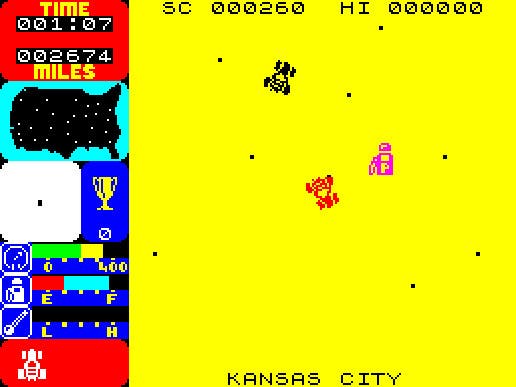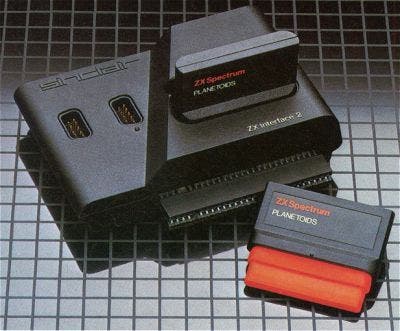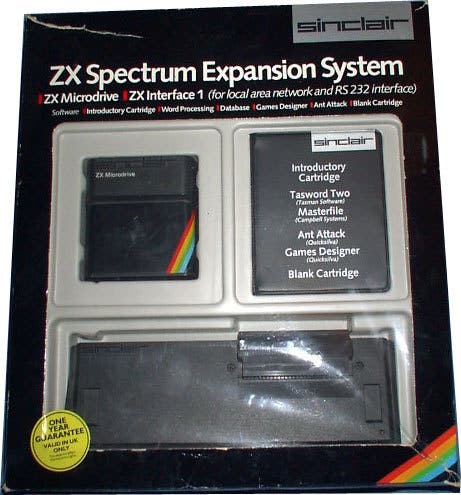Broadening the Spectrum
Somewhere over the rainbow.
The Microdrive may have failed to live up to its early promise, but the ZX Net capabilities tantalisingly pointed towards a future of networked Speccy gaming. In the January 1984 issue of Sinclair User, adventure columnist Quinten Heath envisaged this space-age scenario: "Interface One, the device which attaches the Microdrive to the computer, is possibly more exciting than the Microdrive in its possibilities for adventure writers and players. Using the network you will be able to hook one Spectrum to another and send information between them. That means you could play multiplayer adventure games, with several players moving round different locations, while the computer moves its characters and makes them live."
It sounded amazing. Imagine a version of Mike Singleton's Lords of Midnight, where multiple players explored the icy realm, collaborating on a quest to defeat the evil Doomdark, or even competing to be the first to claim the Ice Crown. Mike went as far as designing a method of connecting two Spectrums using the cassette-player ports, but the transfer rate was so slow (two characters per second) that it was unworkable for network gaming. ZX Net offered transfer rates of 10,000 characters per second, yet Mike never took advantage of the network interface (although it was once rumoured that his long-delayed Dark Sceptre would somehow make use of the Interface 1, but it's unclear exactly how this would have worked).

It wasn't just a pipe dream though, as several games did include support for ZX Net. First up was Protek's Hunter Killer, a submarine simulator which appeared in 1984. Thanks to its two-player network option, you could connect a couple of Spectrums and go into battle against a mate. Each player's game was displayed on a separate TV, adding to the fun as you were never quite sure of what your enemy was plotting. Hunter Killer was followed by two more simulators; Delta Wing and Overlords, both of which allowed for network play in much the same way. But the game that really impressed was TT Racer from Digital Integration. This bike racing simulation let you network up to eight Spectrums, so you could scrape knees with seven other flesh and blood gamers. TT Racer showed the potential of network Spectrum gaming. It's just a shame that so few titles took advantage of the technology.
The Interface 1 may not have changed the face of Spectrum gaming, but then that wasn't Sinclair's aim. That particular job was left to the Interface 2, an add-on designed to turn the Spectrum into a cut-price console. Released in September 1983, hot on the heels of the Interface 1, the new device was essentially a ROM cartridge adapter with the added bonus of twin joystick ports. The plan was to cut out loading times completely by releasing games on plastic cartridges: simply slot the Interface 2 into the back of the Spectrum (or the Interface 1 if connected), plug in a cart and the game was ready to play in an instant. And unlike the Microdrive units, there were no moving parts so nothing could go wrong. Well that was the idea anyway.

Only 10 games were ever released in ROM format - a mixture of old Psion and Ultimate games - and that pretty much sums up the device's dismal failure. The main problem was cost. ROM cartridges initially retailed at £15, where as the tape equivalents were available for around £5. Furthermore, you had to fork out a further £20 for the Interface 2 itself. When you consider that cartridges failed to take off on the Commodore 64, and that machine came with a cartridge port built-in, it was clear that the Interface 2 would not fly off the shelves. What crippled it further was that the cartridges were limited to 16Kb in size. This was because the Interface 2 was unable to page internal memory thanks to the shortcomings of the Spectrum's expansion port. As a result, the ROM cartridge simply shadowed the Spectrum's 16Kb Basic ROM, ruling out the vast library of bigger and better 48Kb titles. More ROM games were lined up for release, but poor sales sledge hammered any future plans.

The Interface 2 may have had more of an impact if Sinclair had signed up software houses to produce exclusive ROM games. It had, after all, convinced Ultimate to re-release four of its back catalogue titles for the new format. Perhaps if Ultimate had released an exclusive ROM game then buyers may have stumped up the cash (or at least taken more notice). Christ, even an exclusive Horace game might have made a difference.
It's telling that the back of the Interface 2 features a streamlined expansion port which only accepts the ZX Printer. Evidently there would be no Interface 3. Sinclair had obviously finished expanding the original Spectrum, and its attentions turned towards the new QL business machine (which foolishly retained faith with the maligned Microdrive system). Spectrum owners, meanwhile, were left twiddling that azimuth adjustment screw on their trusty tape players.








